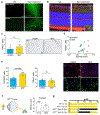NF1 mutation drives neuronal activity-dependent initiation of optic glioma
- PMID: 34040258
- PMCID: PMC8346229
- DOI: 10.1038/s41586-021-03580-6
NF1 mutation drives neuronal activity-dependent initiation of optic glioma
Abstract
Neurons have recently emerged as essential cellular constituents of the tumour microenvironment, and their activity has been shown to increase the growth of a diverse number of solid tumours1. Although the role of neurons in tumour progression has previously been demonstrated2, the importance of neuronal activity to tumour initiation is less clear-particularly in the setting of cancer predisposition syndromes. Fifteen per cent of individuals with the neurofibromatosis 1 (NF1) cancer predisposition syndrome (in which tumours arise in close association with nerves) develop low-grade neoplasms of the optic pathway (known as optic pathway gliomas (OPGs)) during early childhood3,4, raising the possibility that postnatal light-induced activity of the optic nerve drives tumour initiation. Here we use an authenticated mouse model of OPG driven by mutations in the neurofibromatosis 1 tumour suppressor gene (Nf1)5 to demonstrate that stimulation of optic nerve activity increases optic glioma growth, and that decreasing visual experience via light deprivation prevents tumour formation and maintenance. We show that the initiation of Nf1-driven OPGs (Nf1-OPGs) depends on visual experience during a developmental period in which Nf1-mutant mice are susceptible to tumorigenesis. Germline Nf1 mutation in retinal neurons results in aberrantly increased shedding of neuroligin 3 (NLGN3) within the optic nerve in response to retinal neuronal activity. Moreover, genetic Nlgn3 loss or pharmacological inhibition of NLGN3 shedding blocks the formation and progression of Nf1-OPGs. Collectively, our studies establish an obligate role for neuronal activity in the development of some types of brain tumours, elucidate a therapeutic strategy to reduce OPG incidence or mitigate tumour progression, and underscore the role of Nf1mutation-mediated dysregulation of neuronal signalling pathways in mouse models of the NF1 cancer predisposition syndrome.
Conflict of interest statement
Figures










Comment in
-
Activation of retinal neurons triggers tumour formation in cancer-prone mice.Nature. 2021 Jun;594(7862):179-180. doi: 10.1038/d41586-021-01353-9. Nature. 2021. PMID: 34040239 No abstract available.
-
Optic nerve activity promotes the growth of optic pathway gliomas: Shedding light on the glioma microenvironment.Cancer Cell. 2021 Aug 9;39(8):1056-1058. doi: 10.1016/j.ccell.2021.07.010. Cancer Cell. 2021. PMID: 34375609
References
-
- Listernick R, Louis DN, Packer RJ & Gutmann DH Optic pathway gliomas in children with neurofibromatosis 1: consensus statement from the NF1 Optic Pathway Glioma Task Force. Ann. Neurol 41, 143–149 (1997). - PubMed
-
- Listernick R, Charrow J, Greenwald M & Mets M Natural history of optic pathway tumors in children with neurofibromatosis type 1: a longitudinal study. J. Pediatr 125, 63–66 (1994). - PubMed
-
- Bajenaru ML et al. Optic nerve glioma in mice requires astrocyte Nf1 gene inactivation and Nf1 brain heterozygosity. Cancer Res. 63, 8573–8577 (2003). - PubMed
Publication types
MeSH terms
Substances
Grants and funding
LinkOut - more resources
Full Text Sources
Other Literature Sources
Molecular Biology Databases
Research Materials
Miscellaneous

